Commercial and industrial development is developing at a remarkable rate as companies look for long-lasting, reasonably priced, and energy-efficient building solutions. Metal insulated panels are one of the ideas that are gaining popularity quickly. These panels are transforming the design and construction of contemporary structures because of their well-known capacity to provide thermal performance, structural strength, and design freedom.
Design And Durability Meet
Metal insulated panels are valued for their durability in addition to their efficiency. They are perfect for settings where durability is essential since they are impervious to impact, corrosion, and severe weather. These panels last a long time in commercial buildings with heavy traffic and industrial operations, minimising the need for expensive repairs or replacements.
The variety of finishes and design choices they provide further distinguishes them. Developers and architects are no longer compelled to choose between functionality and style. Because metal insulated panels are available in a wide range of hues, textures, and profiles, they may be used to create sleek, contemporary designs that complement brand identities while providing strong protection.
Construction Speed And Cost-Effectiveness
In commercial and industrial undertakings, time is often a crucial component. Metal insulated panels provide a simplified substitute for labour-intensive and time-consuming traditional building techniques. Because they are lightweight, prefabricated, and easy to install, they drastically reduce construction timeframes.
In addition to saving money, shorter construction timeframes enable firms to start up more quickly. The ability to speed up construction without compromising quality is a huge benefit, whether the facility is a logistics centre that has to move merchandise rapidly or a retail shop getting ready for a seasonal rush.
Goals For Green Building And Sustainability
Sustainability is now essential rather than just a fad. Metal insulated panels stand out as a crucial component of sustainable architecture in the worldwide movement to lower carbon footprints and encourage environmentally friendly building practices.
Their lengthy lifetime lowers waste, and their excellent insulating properties lower continuous energy usage. In order to comply with green building standards like LEED, several manufacturers also use recyclable materials in their manufacturing processes. Adopting metal insulated panels may be a visible and useful commitment to sustainability for companies wishing to demonstrate their environmental responsibilities.
Uses In Various Industries
Because of its adaptability, metal insulated panels may be used in a broad range of settings. They are used in factories, distribution centres, and warehouses where efficiency and longevity are critical. They are used by commercial developers for office buildings, retail centres, and hospitality establishments looking for cutting-edge designs with high performance.
Specialised facilities that need panels for a regulated environment are an expanding market where these panels really shine. Labs, pharmaceutical storage facilities, and food processing facilities need tightly regulated environments to maintain the safety and quality of their goods. These tightly regulated areas are supported by metal-insulated panels, which provide the necessary structural and thermal stability.
How Manufacturers Of SIP Panels Link To The Trend
Although metal insulated panels are gaining popularity, prefabricated and high-performance materials are becoming more and more popular across a range of product categories. Manufacturers of structurally insulated panels, like SIP panel manufacturers, which are used in light commercial and residential construction, are also helping to change building standards more broadly. Metal insulated panels and SIPs both prioritise sustainable design, quick installation, and energy efficiency.
This overlap reflects a broader trend in the industry: a shift away from conventional, resource-intensive construction techniques and toward more intelligent, creative solutions. Because of this, companies, architects, and builders have a lot of alternatives that combine sustainability with strength.
The Prospects For The Future
The need for high-performance materials will only increase as building regulations become more stringent and energy prices continue to rise. Efficiency, durability, design flexibility, and speed are just a few of the key advantages that controlled environment panels offer, and they perfectly match the evolving demands of commercial and industrial design.
These panels are rethinking what is feasible in contemporary architecture, from sustaining very delicate, regulated environments to building sustainable logistics facilities. Businesses that embrace them put themselves at the forefront of innovation and guarantee sustainability, efficiency, and environmental responsibility for the long run.




